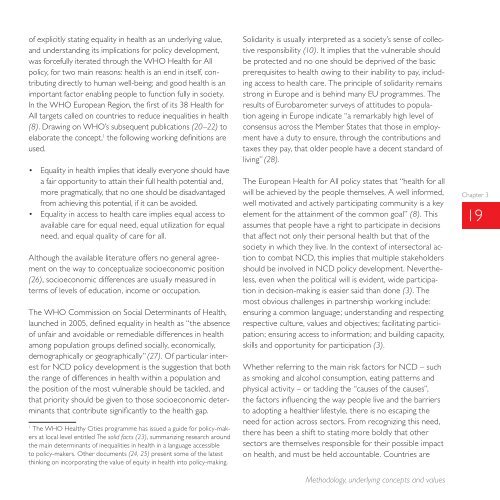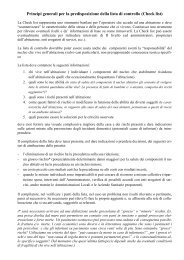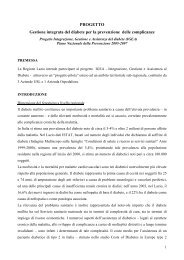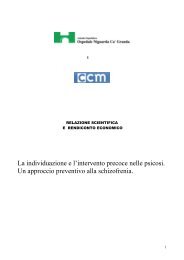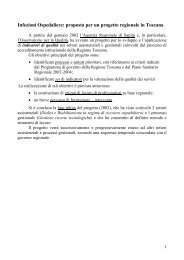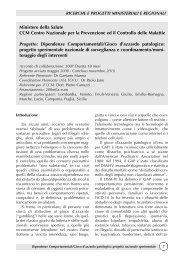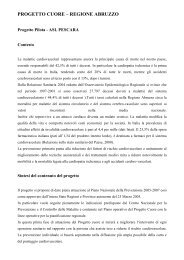Gaining health : analysis of policy development in European ...
Gaining health : analysis of policy development in European ...
Gaining health : analysis of policy development in European ...
Create successful ePaper yourself
Turn your PDF publications into a flip-book with our unique Google optimized e-Paper software.
<strong>of</strong> explicitly stat<strong>in</strong>g equality <strong>in</strong> <strong>health</strong> as an underly<strong>in</strong>g value,<br />
and understand<strong>in</strong>g its implications for <strong>policy</strong> <strong>development</strong>,<br />
was forcefully iterated through the WHO Health for All<br />
<strong>policy</strong>, for two ma<strong>in</strong> reasons: <strong>health</strong> is an end <strong>in</strong> itself, contribut<strong>in</strong>g<br />
directly to human well-be<strong>in</strong>g; and good <strong>health</strong> is an<br />
important factor enabl<strong>in</strong>g people to function fully <strong>in</strong> society.<br />
In the WHO <strong>European</strong> Region, the first <strong>of</strong> its 38 Health for<br />
All targets called on countries to reduce <strong>in</strong>equalities <strong>in</strong> <strong>health</strong><br />
(8). Draw<strong>in</strong>g on WHO’s subsequent publications (20–22) to<br />
elaborate the concept, 1 the follow<strong>in</strong>g work<strong>in</strong>g def<strong>in</strong>itions are<br />
used.<br />
• Equality <strong>in</strong> <strong>health</strong> implies that ideally everyone should have<br />
a fair opportunity to atta<strong>in</strong> their full <strong>health</strong> potential and,<br />
more pragmatically, that no one should be disadvantaged<br />
from achiev<strong>in</strong>g this potential, if it can be avoided.<br />
• Equality <strong>in</strong> access to <strong>health</strong> care implies equal access to<br />
available care for equal need, equal utilization for equal<br />
need, and equal quality <strong>of</strong> care for all.<br />
Although the available literature <strong>of</strong>fers no general agreement<br />
on the way to conceptualize socioeconomic position<br />
(26), socioeconomic differences are usually measured <strong>in</strong><br />
terms <strong>of</strong> levels <strong>of</strong> education, <strong>in</strong>come or occupation.<br />
The WHO Commission on Social Determ<strong>in</strong>ants <strong>of</strong> Health,<br />
launched <strong>in</strong> 2005, def<strong>in</strong>ed equality <strong>in</strong> <strong>health</strong> as “the absence<br />
<strong>of</strong> unfair and avoidable or remediable differences <strong>in</strong> <strong>health</strong><br />
among population groups def<strong>in</strong>ed socially, economically,<br />
demographically or geographically” (27). Of particular <strong>in</strong>terest<br />
for NCD <strong>policy</strong> <strong>development</strong> is the suggestion that both<br />
the range <strong>of</strong> differences <strong>in</strong> <strong>health</strong> with<strong>in</strong> a population and<br />
the position <strong>of</strong> the most vulnerable should be tackled, and<br />
that priority should be given to those socioeconomic determ<strong>in</strong>ants<br />
that contribute significantly to the <strong>health</strong> gap.<br />
1<br />
The WHO Healthy Cities programme has issued a guide for <strong>policy</strong>-makers<br />
at local level entitled The solid facts (23), summariz<strong>in</strong>g research around<br />
the ma<strong>in</strong> determ<strong>in</strong>ants <strong>of</strong> <strong>in</strong>equalities <strong>in</strong> <strong>health</strong> <strong>in</strong> a language accessible<br />
to <strong>policy</strong>-makers. Other documents (24, 25) present some <strong>of</strong> the latest<br />
th<strong>in</strong>k<strong>in</strong>g on <strong>in</strong>corporat<strong>in</strong>g the value <strong>of</strong> equity <strong>in</strong> <strong>health</strong> <strong>in</strong>to <strong>policy</strong>-mak<strong>in</strong>g.<br />
Solidarity is usually <strong>in</strong>terpreted as a society’s sense <strong>of</strong> collective<br />
responsibility (10). It implies that the vulnerable should<br />
be protected and no one should be deprived <strong>of</strong> the basic<br />
prerequisites to <strong>health</strong> ow<strong>in</strong>g to their <strong>in</strong>ability to pay, <strong>in</strong>clud<strong>in</strong>g<br />
access to <strong>health</strong> care. The pr<strong>in</strong>ciple <strong>of</strong> solidarity rema<strong>in</strong>s<br />
strong <strong>in</strong> Europe and is beh<strong>in</strong>d many EU programmes. The<br />
results <strong>of</strong> Eurobarometer surveys <strong>of</strong> attitudes to population<br />
age<strong>in</strong>g <strong>in</strong> Europe <strong>in</strong>dicate “a remarkably high level <strong>of</strong><br />
consensus across the Member States that those <strong>in</strong> employment<br />
have a duty to ensure, through the contributions and<br />
taxes they pay, that older people have a decent standard <strong>of</strong><br />
liv<strong>in</strong>g” (28).<br />
The <strong>European</strong> Health for All <strong>policy</strong> states that “<strong>health</strong> for all<br />
will be achieved by the people themselves. A well <strong>in</strong>formed,<br />
well motivated and actively participat<strong>in</strong>g community is a key<br />
element for the atta<strong>in</strong>ment <strong>of</strong> the common goal” (8). This<br />
assumes that people have a right to participate <strong>in</strong> decisions<br />
that affect not only their personal <strong>health</strong> but that <strong>of</strong> the<br />
society <strong>in</strong> which they live. In the context <strong>of</strong> <strong>in</strong>tersectoral action<br />
to combat NCD, this implies that multiple stakeholders<br />
should be <strong>in</strong>volved <strong>in</strong> NCD <strong>policy</strong> <strong>development</strong>. Nevertheless,<br />
even when the political will is evident, wide participation<br />
<strong>in</strong> decision-mak<strong>in</strong>g is easier said than done (3). The<br />
most obvious challenges <strong>in</strong> partnership work<strong>in</strong>g <strong>in</strong>clude:<br />
ensur<strong>in</strong>g a common language; understand<strong>in</strong>g and respect<strong>in</strong>g<br />
respective culture, values and objectives; facilitat<strong>in</strong>g participation;<br />
ensur<strong>in</strong>g access to <strong>in</strong>formation; and build<strong>in</strong>g capacity,<br />
skills and opportunity for participation (3).<br />
Whether referr<strong>in</strong>g to the ma<strong>in</strong> risk factors for NCD – such<br />
as smok<strong>in</strong>g and alcohol consumption, eat<strong>in</strong>g patterns and<br />
physical activity – or tackl<strong>in</strong>g the “causes <strong>of</strong> the causes”,<br />
the factors <strong>in</strong>fluenc<strong>in</strong>g the way people live and the barriers<br />
to adopt<strong>in</strong>g a <strong>health</strong>ier lifestyle, there is no escap<strong>in</strong>g the<br />
need for action across sectors. From recogniz<strong>in</strong>g this need,<br />
there has been a shift to stat<strong>in</strong>g more boldly that other<br />
sectors are themselves responsible for their possible impact<br />
on <strong>health</strong>, and must be held accountable. Countries are<br />
Methodology, underly<strong>in</strong>g concepts and values<br />
Chapter 3<br />
19


